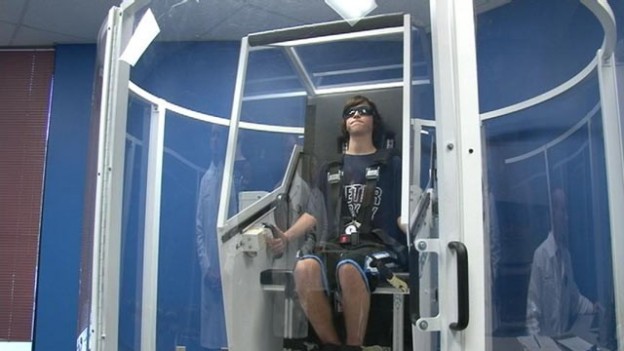Will Arlen has a traumatic brain injury and is so sensitive to light that he wears sunglasses all the time.
The 17-year-old describes his migraines as like a knife stabbing his brain. His short term memory is shot. He can barely stand up on his own or move his left arm.
The teenager from Exeter, N.H., said his symptoms developed after an illegal hit during a lacrosse game gave him a concussion so severe that it sent him into an 8-month downward spiral. His father, Larry Arlen, said his son used to be an active, outgoing, straight-A student, but they have had to pull him out of school because of his condition.
Will, however, believes Ted Carrick, a chiropractor who specializes in the brain, holds the key to a miraculous cure for his condition.
Carrick, who has 28 clinics worldwide and sees patients all over the world, practices a therapy he calls chiropractic neurology, a treatment he has been perfecting for 33 years. He rarely grants interviews, but allowed “Nightline” to be the first American television network to watch the treatment unfold at his clinic at Life University in Marietta, Ga.
He said his treatment involves re-activating pathways in the brain, what scientific circles refer to as neuro-plasticity, by simulating other parts of the body. He is considered the main architect of chiropractic neuology because he pioneered several of the methods used, in part by combining treatments that already exist, as well as developing new treatments.
On average, a week-long therapy costs about $5,000. But Carrick doesn’t turn away patients who can’t afford to pay.
“We’re in the service of humankind, above self,” he said.
When hockey superstar Sidney Crosby suffered serious concussions, he praised Carrick for saving his career. But the doctor wouldn’t go so far as to say his treatment is a “miracle cure.”
“I think miracles are things that happen once in a while,” he said. “What we find is that the miracles that we see, we’re seeing them frequently, every day so they’re not really miracles. What we do is amazing because of what humankind can do.”
When Carrick worked with Arlen, he placed him in front of a full-length mirror, and had him do exercises that would trick his mind’s eye with a mirror image to re-program his brain. It may seem far-fetched, but the results for Arlen were immediate and he could lift his left arm without help.
Carrick’s secret weapon is called the GyroStim, a machine that looks like it belongs to NASA. The patient is strapped into a chair that spins on a double axis, which Carrick said helps stimulate parts of the brain that may be damaged.
When Arlen went inside, he said he feels better. “One thing I’ve noticed is that my breathing feels like it’s not as shallow anymore, that’s the one thing I noticed before,” he said.
Most of Carrick’s patients are referred to him by doctors, but his results are often dismissed as a placebo effect, meaning the patients feel better because they believe in his cure. But the doctor denies that’s the case.
“If it was placebo, we’re doing a pretty darn good job of it,” he said. “What we do is that we do things other people do. We don’t do anything that is really original in our work. We just combine things that other people have done in a different fashion.”
Another patient, Stacey Hubbard, traveled more than 900 miles from Hesston, Kan., to Carrick’s clinic to find out why she can’t walk more than a few steps without stumbling.
“I’m not myself, I’m a dizzy, unbalanced mess,” she said.
A hands-on mother of two, Hubbard said she’s barely gotten out of bed for 10 weeks.
“I haven’t driven, I haven’t been to the grocery store, I haven’t left my bedroom,” she said. “I had to rely on family and friends, my kids’ friends to pick them up and take them to places.”
Hubbard said she just woke up one morning after battling an infection and found her world had turned sideways.
“I sat up and I told my husband, ‘something’s not right,'” she said. “I’m dizzy, everything’s crooked. My floor, my bedroom was literally in my eyes sideways.”
There are plenty of skeptics who say Carrick’s methods do not pass scientific muster, and yet Carrick said he has months-long waiting lists with people desperate to see him for treatment. When he treats Hubbard, he walks her through an exercise where he has her close her eyes and try to relax.
Hubbard said she just woke up one morning after battling an infection and found her world had turned sideways.
“I sat up and I told my husband, ‘something’s not right,'” she said. “I’m dizzy, everything’s crooked. My floor, my bedroom was literally in my eyes sideways.”
There are plenty of skeptics who say Carrick’s methods do not pass scientific muster, and yet Carrick said he has months-long waiting lists with people desperate to see him for treatment. When he treats Hubbard, he walks her through an exercise where he has her close her eyes and try to relax.
“I look very, very carefully and what’s happening with her eyes, with her heads, the degree that her pupils are open or closed, and then her ability to track,” Carrick said. “We find that if we do a certain motion, and we get a different tracking, this is going to have a good probability of working.”
Can Will and Stacey get better with Carrick’s help? Tune into “Nightline” tonight at 11:35 p.m. ET to find out what happens when they enter his treatment program.
For more information about Carrick’s treatment program, visit the Carrick Institute website.


0 Comments